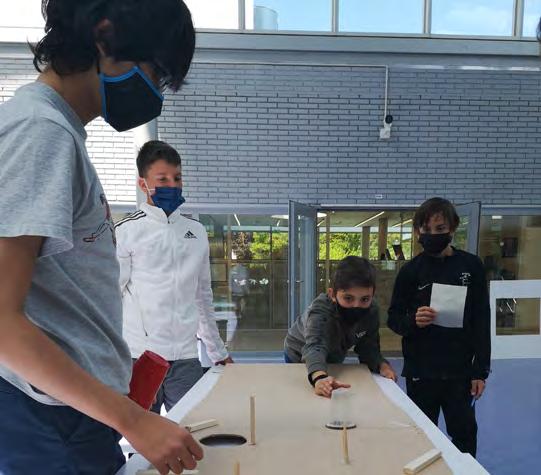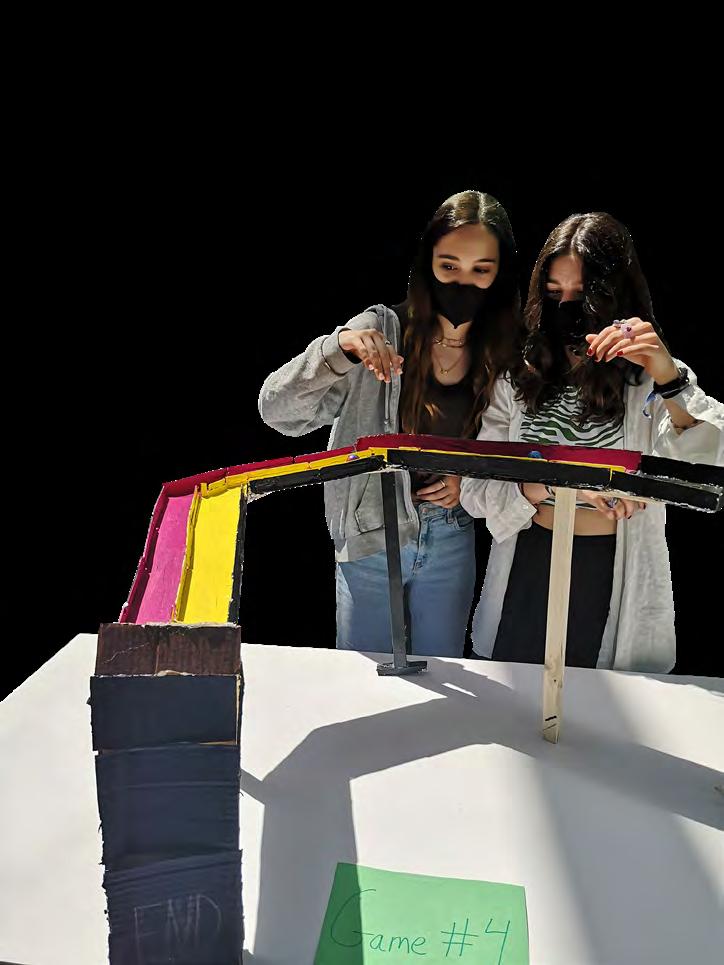
5 minute read
TEACHING AND LEARNING
PROFESSIONAL LEARNING
This year, the teachers and staff members of ASM embodied resilience and together we kept our school open and created the conditions to grow and learn together in uncertain times.
Despite restrictions, setbacks, challenges, and a constantly shifting landscape, we embodied the quote:
“Persistence and resilience only come from having been given the chance to work through difficult problems.” —Gever Tulley
At ASM we aim to facilitate student learning by developing our own practice in collaboration with others. We expect and encourage staff to participate in strategic professional learning in areas that address divisional and school-wide goals.
Collaboration: Supporting and engaging in effective collaboration, building and sustaining powerful teacher teams (aligning units, common collaborative practices)
Coaching Culture: Help build a school-wide culture where giving and receiving non-evaluative feedback with an aim toward continuous growth is a way of being (coaching cycles, peer observations, lab classrooms, trust-building, co-teaching, etc.).
Student Learning: Accelerate learning and focus on instruction across content areas (promoting common instructional practices, bringing student work into conversations, teams and schools, vertical alignment). We believe that on-site, in-depth, job-embedded professional development is the most effective professional learning model to develop the common language, focus, and direction necessary to support the development and successful implementation of instructional practices to support the learning of ASM students now and in the future. Educators in all content areas and grade levels had multiple opportunities throughout the year to engage in ongoing, purposeful learning directly related to their roles and interest areas. Onsite options included:
• K-12 teacher lead workshops: Staff members designed and facilitated over 20 different short, focused workshops featuring best teaching practices, community building, social-emotional learning, and other areas of interest. • Teaching tips and tapas: A year-long lunchtime learning series where staff came together to learn and share around topics such as wellbeing, tech integration, project-based learning, and student engagement. • Google Certification • Cross-disciplinary work and projects: Teachers from different content areas joined forces and engaged in planning projects and lessons together that gave students the chance to learn across grades and subject areas.
Collaboration with our Community: AISiS Cohorts
For the last four years, The American School of Barcelona, The American School of Madrid, The American School of Valencia, and Benjamin Franklin International School have come together to deepen professional learning and collaboration amongst the three schools in order to: • Provide high level, ongoing professional development in both content and instruction with international specialists • Develop ongoing, collaborative connections with colleagues in Spain to raise the level of academic discourse and student achievement

In year four of the collaborative, the learning opportunities expanded to be able to weave in more teachers across content areas, grade levels and provide leadership opportunities for teachers to learn from one another. Despite not having the opportunity to come together in person like in previous years, we crafted a virtual learning menu that was robust and inclusive.
AISiS VISION STATEMENT We are a sustainable community of international educators learning together to achieve dramatic results for teaching and learning
AISiS MISSION STATEMENT To connect and empower a community of educators through meaningful professional learning that transforms classrooms and school
Virtual Professional Learning Options
YEAR-BY-YEAR COHORTS Led by external and/or internal consultants, groups of teachers will meet together multiple times across the year. deepening their learning of best practices and current research. Each cohort session will include practical application to classrooms.
CROSS-SCHOOL COLLABORATIVES Led by teacher facilitators, groups of teachers will meet to dig into a goal, taking part in action research with one another. Collaboratives may need some foundational learning at the start and will include co-constructed instructional tools and communal learning with application to classrooms.
INSTITUTES AND WORKSHOPS Focused learning opportunities that are open to teachers from all schools and a variety of subject areas.

Overview
This year has been an important one as we continue to nurture our curriculum to meet the needs and aspirations of our community. This year we reflected on our recent growth over the last several years through the Middle States Association self-study process. We gathered as a community to voice our aspirations for ASM and turn them into a Mission Statement. We also continued focused work on improving our education practices in some targeted areas. Despite the challenges due to uncertainty and extraordinary circumstances out in the world, this learning community really took the opportunity to set itself up for exciting growth in the coming years.
Middle States Association Self-Study
Every seven years, ASM takes time out of the regular movement of school operations to step back and consider the growth made across every aspect of the school from facilities to student services to our educational programs. Through this self-study which began this spring, we are able to identify and celebrate areas of growth as well as hone in on areas for improvement moving forward.
Stakeholders from across the community, including students, staff, parents, and alumni participated by sharing their thoughts across the twelve standards of the Middle States Association self-study process. Reflective teams were formed around each of the standards to consider and record stakeholder feedback and possible steps forward.
Next year, we will use our study results to engage in strategic planning and continue to learn and grow as an adult community alongside our students. Curriculum Review Cycle
Our curriculum review cycle provides us the opportunity to focus our attention and resources toward making growth in a few key areas each year. This year saw interesting conversations, academic plans, and positive outcomes worth celebrating.
Each subject area moves through the phases of study, development, and implementation across three years. The following three years are intended to engage with, improve on, and otherwise monitor the work done.
The early childhood education team, 6-10 math team, K-10 PE team, 6-12 social studies team, and science teachers have all been working hard to study best practices and improve on our programs here at ASM. The dedication of these teaching teams is admirable. We deeply appreciate the work they do to create the best possible experiences for our students.










